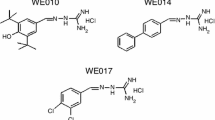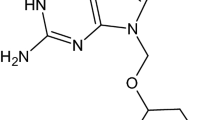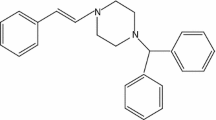Abstract
Thermogravimetry (TG), differential scanning calorimetry (DSC), polarized light thermal microscopy (PLTM), as well as X-ray powder diffraction (XRD) and Fourier transformed infrared spectroscopy (FTIR) were used to study the thermal behavior and the chemical structure of cimetidine, famotidine, ranitidine-HCl, and nizatidine. The TG–DSC curves show that the famotidine and ranitidine-HCl suffer decomposition during melting and they are thermally less stable in comparison with cimetidine and nizatidine, the latter being the most stable of all the drugs studied in this study. The DSC curves of famotidine and ranitidine-HCl show exothermic peaks immediately after the melting, confirming the occurrence of thermal decomposition. The DSC curves also show that the cimetidine and nizatidine have some thermal stability after melting. The thermal events shown in the PLTM images are consistent with the results shown in the TG–DSC and DSC curves. The XRD patterns show that the cimetidine and famotidine are less crystalline compared with ranitidine-HCl and nizatidine. The theoretical FTIR bands are in agreement with those obtained experimentally, and in some cases, no difference is observed between the theoretical and experimental values, even being identical in one of the cases.
Similar content being viewed by others
Explore related subjects
Discover the latest articles, news and stories from top researchers in related subjects.Avoid common mistakes on your manuscript.
Introduction
Cimetidine, famotidine, ranitidine, and nizatidine are drugs used for the ulcer treatment. They are histamine H2-receptor antagonists which are drugs capable of reducing the acid gastric secretion stimulated by histamine [1–4].
A pharmaceutical preparation consists of a drug(s) or active ingredient(s) together with so-called excipients or inactive ingredients (fillers, additives, etc.), all of which must be present in the correct proportions. Pharmaceutical preparations [5–8] provide the means by which pharmaceutically active substances or drugs can be supplied to the body, so that both the physiological considerations concerning the means of application (oral, cutaneous, sub-cutaneous, and rectal, etc.) and the physicochemical properties of the drug are suitable.
Thermal methods of analysis are widely used for checking thermal decomposition, thermal stability, polymorphism, reactions in solid state, drug formulations, purity, and other properties of solid compounds used in pharmaceutical industry [6–14]. Because of the numerous issues involved, it becomes important to have a complete understanding of the properties of pharmaceuticals.
Theoretical calculations help in interpretations of Fourier transformed infrared (FTIR) spectra supplying structural and physicochemical parameters [14].
Thus, this article aims to the thermal and structural characterization of the following antihistamines: cimetidine, famotidine, ranitidine-HCl, and nizatidine.
Experimental
Samples of cimetidine (batch 20090401 #4) and famotidine (batch FM/005/8035 #2) were purchased from Deg™. Ranitidine-HCl (batch 1003032003) and nizatidine (batch 129K1192) samples were purchased from Galena™ and Fluka®, respectively.
Simultaneous thermogravimetry (TG)–differential scanning calorimetry (DSC) curves were obtained with thermal analysis system, model TGA/DSC 1 Stare System (Mettler Toledo). The purge gas was an air flow of 50 mL min−1. A heating rate of 20 °C min−1 was adopted, with samples weighing about 5 mg. Alumina crucible was used for TG–DSC curves.
DSC curves were obtained with thermal analysis systems model Q-10 (TA Instruments). The purge gas was an air flow of 50 mL min−1. A heating rate of 20 °C min−1 was adopted with sample masses between 3 and 5 mg. Aluminum crucibles, with perforated cover, were used for recording the DSC curves.
For optical observation, a Leica DMRB microscope, a Sony CCD-IRIS/RGB video camera and Sony HR Triniton monitor were used. Real Time Video Measurement System software by Linkam was used for image analysis. A small amount of the drug was dispersed throughout the sample cell, and covered by a cap. The dispersion aims to study the thermal behavior of individual particles, which is very useful when the drug presents a thermal behavior heterogeneous. The images were obtained by means of combined use of polarized light and wave compensators, giving to the background image a single color and not black.
Infrared spectra were obtained directly by reflectance on a spectrophotometer model FTIR Nicolet iS10 (Thermo Scientific), within the 4,000–600 cm−1 range, using an attenuated total reflection (ATR) accessory with a germanium crystal as holder.
The X-ray powder diffraction (XRD) patterns were obtained by means of a Siemens D-5000 X-ray diffractometer, employing Cu Kα radiation (λ = 1.541 Å) and settings of 40 kV and 20 mA. The sample was placed in the support of the equipment (a glass support) and submitted to radiation (5° ≤ 2θ ≤ 70°).
In this study, theoretical calculations were used to determine the molecular geometry, infrared spectra of the molecules of the cimetidine, famotidine, ranitidine-HCl, and nizatidine. The quantum chemical approach employed was the three-parameter hybrid theory of Becke [15] using the correlation potential of Lee–Yang–Parr (LYP) [16], and the atomic basis used was the 6-311++g(d) [17, 18] enriched with two diffuse functions and a function of polarization. For the determination of the infrared spectrum was used harmonic field [19] based on the C1 symmetry (electronic state 1A). The values of frequencies were not scaled, being presented the values of the frequencies, its relative intensities and the description of vibrational modes. The calculations of the vibrational frequencies were also used to determine whether the optimized geometries are a global energy minimum or a saddle point. The Berny algorithm [20] was used for the optimization of the geometries. The molecular calculations were performed using the Gaussian 09 program [21]. The descriptions of the main active vibrational modes were performed with the help of the graphic program GaussView 5.0.8 [22].
Results and discussion
Thermal analysis
Figure 1a shows that the anhydrous cimetidine displays thermal stability up to 192 °C. It is observed an endothermic peak at 147 °C in the simultaneous TG–DSC curves, which is attributed to the melting of the drug. The drug decomposes in two steps. The first step occurs between 192 and 390 °C, with a mass loss of 54.34%, and it is associated to the exothermic peak at 300 °C. The second step occurs between 390 and 750 °C, with a mass loss of 45.66%, and it is associated to the exotherm between 466 and 750 °C. These thermal events are attributed to decomposition/oxidation of organic matter. The DSC curve (Fig. 2a) shows an endothermic peak at 145 °C (Tonset = 140 °C) attributed to the melting of the drug. The peak temperature observed in this study was consistent with the reports of other authors [23, 24].
Figure 1b shows that the anhydrous famotidine presents thermal stability up to 173 °C. It is observed an endothermic peak at 168 °C (TG–DSC curves) which is attributed to the melting of the drug. The drug decomposes in two steps. The first step occurs between 173 and 400 °C, with a mass loss of 39.10%, and it is associated to the exothermic peaks at 207 and 282 °C. The second step occurs between 400 and 1000 °C with a mass loss of 60.37%, and it is associated to the exotherm between 660 and 900 °C. The residue of 0.53% is attributed to the ash resulting from the thermal decomposition of the drug. These events are attributed to thermal decomposition/oxidation of organic matter. The DSC curve (Fig. 2b) shows an endothermic peak at 166 °C (Tonset = 161 °C) attributed to the melting of the drug. The peak temperature is consistent with the form B of famotidine reported in the literature [25].
Figure 1c shows that the anhydrous ranitidine-HCl displays thermal stability up to 147 °C. It is observed an endothermic peak at 151 °C in the simultaneous TG–DSC curves, which is attributed to the melting of the drug, associated to an exothermic peak at 176 °C, indicating that the drug decomposes itself during melting. The drug decomposes in two steps. The first step occurs between 147 and 340 °C, with a mass loss of 55.29%, and is associated with the exothermic peaks at 176 and 257 °C in the TG–DSC curves. The second step occurs between 340 and 900 °C with a mass loss of 43.40%, and it is associated to the exothermic peak at 534 °C. The residue of 1.31% is attributed to the ash resulting from the thermal decomposition of the drug. These events are attributed to thermal decomposition/oxidation of organic matter. The DSC curve (Fig. 2c) shows an endothermic peak at 150 °C (Tonset = 144 °C) attributed to the melting of the drug. The peak temperature is in disagreement with those reported found in the literature [26]. These discrepancies may be attributed to the different experimental conditions in the attainment of DSC curves.
Figure 1d shows that the anhydrous nizatidine-HCl displays thermal stability up to 200 °C. It is observed an endothermic peak at 138 °C in the simultaneous TG–DSC curves which is attributed to the melting of the drug. The drug decomposes in two steps. The first step occurs between 200 and 400 °C, with mass loss of 53.16%, and it is associated to the exothermic peak in 242 °C. This large and sharp peak is due to the decomposition of the drug, with the release of NO2 groups. The release of groups NO2 was confirmed through qualitative test (the heating of the drug releases a brownish smoke. It confirms the elimination of NO2 groups). The second step of decomposition occurs between 400 and 900 °C, with a mass loss of 46.54%, and it is associated to the exotherm between 402 and 785 °C in the DSC curve. The residue of 0.3% is attributed to the ash resulting from the thermal decomposition of the drug. These thermal events are attributed to decomposition/oxidation of organic matter. The DSC curve (Fig. 2d) shows an endothermic peak at 133 °C (Tonset = 124 °C) attributed to the melting of the drug.
The simultaneous TG–DSC curves show that the thermal stability of the drugs studied in this study increases in the following order: ranitidine-HCl < famotidine < cimetidine < nizatidine.
Polarized light thermal microscopy (PLTM)
Figure 3 shows that the cimetidine melts itself at 141 °C and evidence neither of crystalline transition during the heating process of the drug, nor of recrystallization during its cooling process was observed. These results are in accordance with those found in the literature [24].
According to DSC curves (Fig. 2b, c), the famotidine and ranitidine-HCl decomposes itself during melting and do not suffer any kind of crystalline transition during heating. This thermal behavior can be confirmed by the images obtained through the experiments of thermal microscopy (Fig. 3). The analysis of results shows that the famotidine melts itself at 163 °C, and it neither undergoes any crystalline transition during the heating process nor recrystallizes during the cooling process. At 32 °C, it is possible to verify the presence of brown spots, attributed to the compounds formed during the decomposition of the drug, and which solidifies during the cooling process of the sample. The ranitidine-HCl melts at 141 °C, it neither undergoes crystalline transition during the heating process, nor recrystallizes during the cooling process.
Figure 3 shows that the nizatidine melts at 132 °C and evidence neither of crystalline transition during the heating process of the drug, nor of recrystallization during its cooling process was observed, even after the sample being kept at 25 °C for 3 days, after cooling.
X-ray diffraction
The XRD patterns (figure not shown) indicates that cimetidine and famotidine are less crystalline compared with ranitidine-HCl and nizatidine.
FTIR with ATR
The FTIR theoretical and experimental data are shown in Table 1. The results indicates that the theoretical bands of FTIR are in agreement to those obtained experimentally, since that in some cases there is no significant difference between the theoretical and experimental values, being even identical in one of the cases. All these bands are in agreement to those found in the literature [2–4, 25, 27] and the theoretical structures for each drug are shown in Fig. 4, with its theoretical data depicted in Tables 2, 3, 4, 5.
Conclusions
The TG–DSC curves provided information on the thermal stability of the compounds studied, which increases in the following order: ranitidine-HCl < famotidine < cimetidine < nizatidine.
The thermomicroscopy experiments confirmed the information obtained from the analysis of TG–DSC and DSC curves, in relation to thermal stability and thermal decomposition of the compounds studied. These experiments also revealed information about the irreversibility of thermal processes that occurs during heating and cooling of the antihistamines studied.
The XRD patterns allowed observing that cimetidine and famotidine are less crystalline compared with ranitidine-HCl and nizatidine.
The quantum calculations performed allowed the comparison between the theoretical and experimental absorption bands, for each of the four drugs studied, since in some cases, virtually no differences between the theoretical and experimental values, being even identical in one of the cases. All absorption bands are very close to those found in the literature.
References
Hoyte FCL, Katial RK. Antihistamine therapy in allergic rhinitis. Immunol Allergy Clin N Am. 2011;31:509–43.
Bavin PMG, et al. Cimetidine. In: Florey K, editor. Analytical profiles of drug substances. New York: Academic Press; 1984. p. 128–81.
Hohnjec M, et al. Ranitidine. In: Florey K, editor. Analytical profiles of drug substances. New York: Academic Press; 1984. p. 533–61.
Wozniak TJ. Nizatidine. In: Florey K, editor. Analytical profiles of drug substances. New York: Academic Press; 1984. p. 397–424.
The Merck Index, Merck & Co. Inc., 11th ed. New York: Rohway; 1989.
Schmidt AC, Senfter N, Ferroni DC, Griesser UJ. Crystal polymorphism of local anaesthetic drugs. J Therm Anal Calorim. 2003;73:397–408.
Plano D, Lizarraga E, Palop JA, Sanmartín C. Study of polymorphism of organosulfur and organoselenium compounds. J Therm Anal Calorim. 2011;105:1007–13.
Giordano F, Novak C, Moyano JR. Thermal analysis of cyclodextrins and their inclusion compounds. Thermochim Acta. 2001;380:123–51.
Neto HS, Novak C, Matos JR. Thermal analysis and compatibility studies of prednicarbate with excipients used in semi solid pharmaceutical form. J Therm Anal Calorim. 2009;97:367–74.
Bernardi LS, Oliveira PR, Murakami FS, Silva MAS, Borgmann SHM, Cardoso SG. Characterization of venlafaxine hydrochloride and compatibility studies with pharmaceutical excipients. J Therm Anal Calorim. 2009;97:729–33.
Petit S, Mallet F, Petit MN, Coquerel G. Role of structural and macrocrystalline factors in the desolvation behaviour of cortisone acetate solvates. J Therm Anal Calorim. 2007;90:39–47.
Wesolowski M, Szynkaruk P. Thermal decomposition of purine derivatives used in medicine. J Therm Anal Calorim. 2001;65:599–605.
Schnitzler E, Kobelnik M, Sotelo GFC, Bannach G, Ionashiro M. Thermoanalytical study of purine derivatives compounds. Ecl Quim. 2004;29:71–8.
Bannach G, Arcaro R, Ferroni DC, Siqueira AB, Treu-Filho O, Ionashiro M, Schnitzler E. Thermal analytical study of some anti-inflammatory analgesic agents. J Therm Anal Calorim. 2010;102:163–70.
Becke AD. Density-functional thermochemistry. 3. The role of exact exchange. J Chem Phys. 1993;98:5648–52.
Lee C, Yang W, Parr RG. Development of the Colle–Salvetti correlation-energy formula into a functional of the electron density. Phys Rev B. 1988;37:785–9.
Petersson GA, et al. A complete basis set model chemistry. I. The total energies of closed-shell atoms and hydrides of the first-row atoms. J Chem Phys. 1988;89:2193–218.
Petersson GA, Al-Laham MA. A complete basis set model chemistry. II. Open-shell systems and the total energies of the first-row atoms. J Chem Phys. 1991;94:6081–90.
Goodson DZ, Sarpal SK, Wolfsberg M. Influence on isotope effect calculations of the method of obtaining force constants from vibrational data. J Phys Chem. 1982;86:659–63.
Li X, Frisch MJ. Energy-represented DIIS within a hybrid geometry optimization method. J Chem Theory Comput. 2006;2:835–9.
Frisch, MJ et al. Gaussian 09, Revision A.02.Wallingford: Gaussian, Inc.; 2009.
Dennington R, Keith T, Millam J. GaussView, Version 5.0.8, Semichem Inc., Shawnee Mission KS; 2000–2008.
Sanders GHW, et al. Discrimination of polymorphic forms of a drug product by localized thermal analysis. J Microsc. 2000;198:77–81.
Souza FS, Macedo RO, Veras JWE. Studies of cimetidine pre-formulated and tablets for TG and DSC coupled to the photovisual system. Thermochim Acta. 2002;392–3:99–106.
Lin SY, Cheng WT, Wang SL. Thermodynamic and kinetic characterization of polymorphic transformation of famotidine during grinding. Int J Pharm. 2006;318:86–91.
Mirmehrabi M, et al. Characterization of tautomeric forms of ranitidine hydrochloride: thermal analysis, solid-state NMR, X-ray. J Cryst Growth. 2004;260:517–26.
Al-Omar MA, Al-Mohizea AM. Famotidine. In: Brittain HG, editor. Profiles of drug substances, excipients and related methodology. Amsterdan: Elsevier; 2009. p. 115–51.
Acknowledgements
The authors thank FUNDUNESP, PROPe-UNESP, PROPG-UNESP, FC-UNESP, and POSMAT-UNESP for the financial support. The authors also thank Prof. Dr. Massao Ionashiro by the use their equipment, TG–DTA, DSC, FTIR and the Center for Scientific Computing (NCC/GridUNESP) of Universidade Estadual Paulista (UNESP), Instituto de Quimica de Araraquara, UNESP Campus de Araraquara and CENAPAD—UNICAMP.
Author information
Authors and Affiliations
Corresponding author
Rights and permissions
About this article
Cite this article
Perpétuo, G.L., Gálico, D.A., Fugita, R.A. et al. Thermal behavior of some antihistamines. J Therm Anal Calorim 111, 2019–2028 (2013). https://doi.org/10.1007/s10973-012-2247-0
Received:
Accepted:
Published:
Issue Date:
DOI: https://doi.org/10.1007/s10973-012-2247-0








